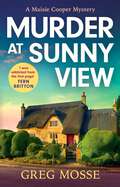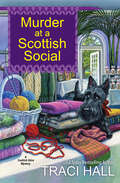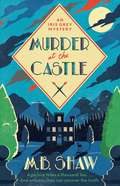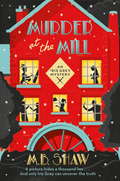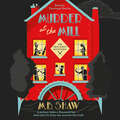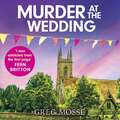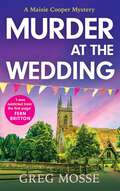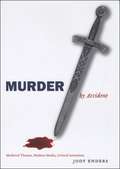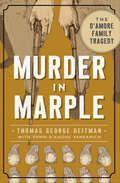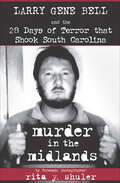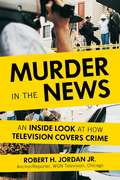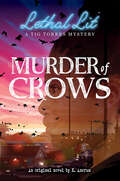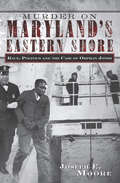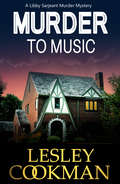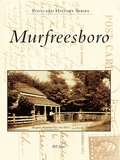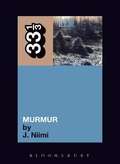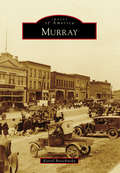- Table View
- List View
Murder at Sunny View: An absolutely gripping and charming cozy murder mystery novel for 2025 (A Maisie Cooper Mystery)
by Greg Mosse'Maisie Cooper is a brilliant main character, an everyday Miss Marple!... I love cosy crime and I loved this book!' Reader review ⭐⭐⭐⭐⭐ It's not all sunshine and blue skies at Sunny View guesthouse, as a suspicious death means Maisie Cooper has her hands full with a new investigation...Amateur sleuth Maisie Cooper had hoped for a peaceful weekend at Sunny View guesthouse in the heart of the Devonshire countryside. But Maisie instead finds herself amidst another mystery embroiling the small hamlet of Trout Leap.When the body of one of the villagers is found lying dead by the river, Maisie is convinced that this is more than just an accident. She can't help but feel that the murder is somehow connected to the ongoing mystery at Trout Leap. Is someone hiding something? Who would commit such a crime? And can Maisie crack the case, before the killer strikes again?Don't miss the next instalment in the Maisie Cooper Mystery series, Murder at Sunny View, perfect for fans of Peter Boland and Clare Chase!Everyone is gripped by the Maisie Cooper Mysteries:'Maisie Cooper is a brilliant main character, an everyday Miss Marple!... I love cosy crime and I loved this book!' Reader review ⭐⭐⭐⭐⭐'Fans of Osman are in for a treat!' Peter James'Fabulous, full of wit, mystery, romance and small town politics... The characters are witty, quirky... The plot is twisty and engaging with lots of red herrings' Reader review ⭐⭐⭐⭐⭐'I loved the way that I was pulled into the mystery... I found myself constantly looking for potential clues which made it feel like a real puzzle to get stuck into. I had a lot of fun reading this book' Reader review ⭐⭐⭐⭐⭐'I was addicted from the first page' Fern Britton'Mixes classic whodunnit with cozy mystery elements... Kept me guessing... I thoroughly enjoyed it' Reader review ⭐⭐⭐⭐⭐
Murder at Sunny View: An absolutely gripping and charming cozy murder mystery novel for 2025 (A Maisie Cooper Mystery)
by Greg Mosse'Maisie Cooper is a brilliant main character, an everyday Miss Marple!... I love cosy crime and I loved this book!' Reader review ⭐⭐⭐⭐⭐ It's not all sunshine and blue skies at Sunny View guesthouse, as a suspicious death means Maisie Cooper has her hands full with a new investigation...Amateur sleuth Maisie Cooper had hoped for a peaceful weekend at Sunny View guesthouse in the heart of the Devonshire countryside. But Maisie instead finds herself amidst another mystery embroiling the small hamlet of Trout Leap.When the body of one of the villagers is found lying dead by the river, Maisie is convinced that this is more than just an accident. She can't help but feel that the murder is somehow connected to the ongoing mystery at Trout Leap. Is someone hiding something? Who would commit such a crime? And can Maisie crack the case, before the killer strikes again?Don't miss the next instalment in the Maisie Cooper Mystery series, Murder at Sunny View, perfect for fans of Peter Boland and Clare Chase!Everyone is gripped by the Maisie Cooper Mysteries:'Maisie Cooper is a brilliant main character, an everyday Miss Marple!... I love cosy crime and I loved this book!' Reader review ⭐⭐⭐⭐⭐'Fans of Osman are in for a treat!' Peter James'Fabulous, full of wit, mystery, romance and small town politics... The characters are witty, quirky... The plot is twisty and engaging with lots of red herrings' Reader review ⭐⭐⭐⭐⭐'I loved the way that I was pulled into the mystery... I found myself constantly looking for potential clues which made it feel like a real puzzle to get stuck into. I had a lot of fun reading this book' Reader review ⭐⭐⭐⭐⭐'I was addicted from the first page' Fern Britton'Mixes classic whodunnit with cozy mystery elements... Kept me guessing... I thoroughly enjoyed it' Reader review ⭐⭐⭐⭐⭐
Murder at a Scottish Social (A Scottish Shire Mystery #3)
by Traci HallSweater shop owner Paislee Shaw puts the yarn in Nairn, but a killer has put poison in some Scottish shortbread cookies . . . Opening her shop Cashmere Crush and making a new home for herself, her son Brody, Gramps, and their black Scottish terrier Wallace in the beautiful Scottish village of Nairn is a dream come true. So Paislee is happy to give back by donating a luxurious cashmere sweater for an auction to raise money for the Nairn Food Bank. She&’s less happy to make the acquaintance of a clique of competitive moms at the charity event, who treat a baking contest like it&’s life or death. It turns out to be the latter for Queen Bee Kirsten Buchanan when a peanut-laced shortbread cookie triggers her fatal nut allergy. Who would poison Kirsten? How about half the town? But when Paislee&’s pal Blaise is suspected, the sweater-selling sleuth leaps into action to unravel the mystery. Along with gruff but handsome DI Mack Zeffer, she has to sort through a batch of suspects without becoming this cookie-cutter killer&’s next target . . .
Murder at the Castle
by MB ShawIris Grey arrives at Pitfeldy Castle in the Highlands, at the request of the Baron, Jock MacKinnon. Jock has commissioned Iris to paint a portrait of his fiancé, an American socialite Kathy Miller, ahead of their New Year wedding.Kathy invites Iris into her confidence, she's received a series of threatening notes asking her to call off the wedding. Iris begins to investigate, and when remains are discovered in the grounds of the Castle, she fears for Kathy's safety.With the wedding fast approaching, Iris once again enters a world of family feuds, romantic intrigue, buried secrets and murder.
Murder at the Mill: A cozy mystery puzzle for readers who enjoy MC Beaton (The Iris Grey Mysteries)
by Tilly Bagshawe M. B. Shaw'A great sweeping adventure' MC Beaton, author of the bestselling Agatha Raisin seriesIris Grey arrives at Mill Cottage in a picture-perfect Hampshire village, looking to escape from her crumbling marriage. She is drawn to the neighbouring Wetherby family, and is commissioned to paint a portrait of Dominic Wetherby, a celebrated crime writer. At the Wetherby's family party, the wine is in full flow - but so too are tensions and rivalries among the guests. The next day, the youngest member of the Wetherby family, Lorcan, finds a body in the water. A tragic accident? Or a deadly crime?Iris enters a world of village gossip, romantic intrigue, buried secrets and murder.Readers love MURDER AT THE MILL:'All the ingredients are there, snow, strange characters, body - a great read''A perfectly cosy little whodunnit. It was perfect for bedtime and kept me turning pages.''This is a cosy book to curl up with on a rainy Sunday afternoon - as I did today, I really enjoyed and recommend.
Murder at the Mill: A cozy mystery puzzle for readers who enjoy MC Beaton (The Iris Grey Mysteries)
by Tilly Bagshawe M. B. ShawAs featured in the Sunday Times, the first festive mystery in a new crime series from bestselling author Tilly Bagshawe - a must-read for fans of Agatha Christie's Marple and Midsomer Murders.Iris Grey arrives at Mill Cottage in a picture-perfect Hampshire village, looking to escape from her crumbling marriage. She is drawn to the neighbouring Wetherby family, and is commissioned to paint a portrait of Dominic Wetherby, a celebrated crime writer.At the Wetherby's Christmas Eve party, the mulled wine is in full flow - but so too are tensions and rivalries among the guests. On Christmas Day, the youngest member of the Wetherby family, Lorcan, finds a body in the water. A tragic accident? Or a deadly crime? With the snow falling, Iris enters a world of village gossip, romantic intrigue, buried secrets and murder.Read by Penelope Rawlins(p) Orion Publishing Group
Murder at the Wedding: A gripping and addictive British cozy murder mystery (A Maisie Cooper Mystery)
by Greg MosseDon't miss the sixth instalment in the Maisie Cooper Mystery Series, Murder at the Wedding, available to pre-order now!Maisie Cooper is ready to tie the knot... but first she needs to untangle one last mystery...Amateur sleuth Maisie Cooper is busy planning her wedding to police officer Jack Wingard. After a tumultuous six months solving various murder investigations, she is excited to finally marry her childhood sweetheart.But not everyone is happy for the bride-to-be...Maisie dismisses a few strange 'accidents' targeting her and Jack as pure coincidences. But when she receives a threatening note, Maisie can't deny that someone is after her. Someone who wants revenge.As her wedding day approaches, Maisie realises that there are a fair few people from her past who might want her dead. Will Maisie make it safely down the aisle? Or will she have one final murder to solve before she says 'I do'?Catch up on the rest of the series, which can also be read as standalones:Murder at Church LodgeMurder at Bunting ManorMurder at the TheatreMurder at the FairMurder at Sunny ViewEveryone is gripped by the Maisie Cooper Mysteries:'Maisie Cooper is a brilliant main character, an everyday Miss Marple!... I love cosy crime and I loved this book!' Reader review ⭐⭐⭐⭐⭐'Fans of Osman are in for a treat!' Peter James'Fabulous, full of wit, mystery, romance and small town politics... The characters are witty, quirky... The plot is twisty and engaging with lots of red herrings' Reader review ⭐⭐⭐⭐⭐'I loved the way that I was pulled into the mystery... I found myself constantly looking for potential clues which made it feel like a real puzzle to get stuck into. I had a lot of fun reading this book' Reader review ⭐⭐⭐⭐⭐'I was addicted from the first page' Fern Britton'Mixes classic whodunnit with cozy mystery elements... Kept me guessing... I thoroughly enjoyed it' Reader review ⭐⭐⭐⭐⭐
Murder at the Wedding: A gripping and addictive British cozy murder mystery (A Maisie Cooper Mystery)
by Greg MosseMaisie Cooper is ready to tie the knot... but first she needs to untangle one last mystery...Amateur sleuth Maisie Cooper is busy planning her wedding to police officer Jack Wingard. After a tumultuous six months solving various murder investigations, she is excited to finally marry her childhood sweetheart.But not everyone is happy for the bride-to-be...Maisie dismisses a few strange 'accidents' targeting her and Jack as pure coincidences. But when she receives a threatening note, Maisie can't deny that someone is after her. Someone who wants revenge.As her wedding day approaches, Maisie realises that there are a fair few people from her past who might want her dead. Will Maisie make it safely down the aisle? Or will she have one final murder to solve before she says 'I do'?Don't miss the sixth instalment in the Maisie Cooper Mystery Series, Murder at the Wedding, perfect for fans for Clare Chase and Dee MacDonald!Catch up on the rest of the series, which can also be read as standalones:Murder at Church LodgeMurder at Bunting ManorMurder at the TheatreMurder at the FairMurder at Sunny ViewEveryone is gripped by the Maisie Cooper Mysteries:'Maisie Cooper is a brilliant main character, an everyday Miss Marple!... I love cosy crime and I loved this book!' Reader review ⭐⭐⭐⭐⭐'Fans of Osman are in for a treat!' Peter James'Fabulous, full of wit, mystery, romance and small town politics... The characters are witty, quirky... The plot is twisty and engaging with lots of red herrings' Reader review ⭐⭐⭐⭐⭐'I loved the way that I was pulled into the mystery... I found myself constantly looking for potential clues which made it feel like a real puzzle to get stuck into. I had a lot of fun reading this book' Reader review ⭐⭐⭐⭐⭐'I was addicted from the first page' Fern Britton'Mixes classic whodunnit with cozy mystery elements... Kept me guessing... I thoroughly enjoyed it' Reader review ⭐⭐⭐⭐⭐
Murder at the Wedding: A gripping and addictive British cozy murder mystery (A Maisie Cooper Mystery)
by Greg MosseMaisie Cooper is ready to tie the knot... but first she needs to untangle one last mystery...Amateur sleuth Maisie Cooper is busy planning her wedding to police officer Jack Wingard. After a tumultuous six months solving various murder investigations, she is excited to finally marry her childhood sweetheart.But not everyone is happy for the bride-to-be...Maisie dismisses a few strange 'accidents' targeting her and Jack as pure coincidences. But when she receives a threatening note, Maisie can't deny that someone is after her. Someone who wants revenge.As her wedding day approaches, Maisie realises that there are a fair few people from her past who might want her dead. Will Maisie make it safely down the aisle? Or will she have one final murder to solve before she says 'I do'?Don't miss the sixth instalment in the Maisie Cooper Mystery Series, Murder at the Wedding, perfect for fans for Clare Chase and Dee MacDonald!Catch up on the rest of the series, which can also be read as standalones:Murder at Church LodgeMurder at Bunting ManorMurder at the TheatreMurder at the FairMurder at Sunny ViewEveryone is gripped by the Maisie Cooper Mysteries:'Maisie Cooper is a brilliant main character, an everyday Miss Marple!... I love cosy crime and I loved this book!' Reader review ⭐⭐⭐⭐⭐'Fans of Osman are in for a treat!' Peter James'Fabulous, full of wit, mystery, romance and small town politics... The characters are witty, quirky... The plot is twisty and engaging with lots of red herrings' Reader review ⭐⭐⭐⭐⭐'I loved the way that I was pulled into the mystery... I found myself constantly looking for potential clues which made it feel like a real puzzle to get stuck into. I had a lot of fun reading this book' Reader review ⭐⭐⭐⭐⭐'I was addicted from the first page' Fern Britton'Mixes classic whodunnit with cozy mystery elements... Kept me guessing... I thoroughly enjoyed it' Reader review ⭐⭐⭐⭐⭐
Murder by Accident: Medieval Theater, Modern Media, Critical Intentions
by Jody EndersOver fifty years ago, it became unfashionable--even forbidden--for students of literature to talk about an author's intentions for a given work. InMurder by Accident, Jody Enders boldly resurrects the long-disgraced concept of intentionality, especially as it relates to the theater. Drawing on four fascinating medieval events in which a theatrical performance precipitated deadly consequences, Enders contends that the marginalization of intention in critical discourse is a mirror for the marginalization--and misunderstanding--of theater. Murder by Accidentrevisits the legal, moral, ethical, and aesthetic limits of the living arts of the past, pairing them with examples from the present, whether they be reality television, snuff films, the "accidental" live broadcast of a suicide on a Los Angeles freeway, or an actor who jokingly fired a stage revolver at his temple, causing his eventual death. This book will force scholars and students to rethink their assumptions about theory, intention, and performance, both past and present.
Murder in Marple: The D’Amore Family Tragedy (True Crime)
by Thomas George DeitmanBenjamin D'Amore abused his wife for the last time on November 29, 1949. That night, his sons John and Nicholas exacted revenge and executed Benjamin with a shotgun and deer rifle. The trial that followed was unlike many before it. Two psychiatrists diagnosed the brothers with "catathymic crisis," which inhibited their judgment during the crime. But despite the defendants' guilty plea, an all-female jury acquitted them. Thomas Deitman and Dawn D'Amore Yankanich unravel the horrific events and conspiracies regarding the shocking patricide case.
Murder in Michigan's Upper Peninsula (True Crime)
by Sonny LongtineResidents of the idyllic villages scattered throughout the Upper Peninsula's richly forested paradise live in quiet comfort for the most part, believing that murder rarely happens in their secluded sanctuary3/4but it does, and more often than they realize. This collection of twenty-four legendary murders spans 160 years of Upper Michigan's history and dispels the notion that murder in the Upper Peninsula is an anomaly. From the bank robber who killed the warden and deputy warden of the Marquette Branch Prison to the unknown assailant who gunned down James Schoolcraft in Sault Ste. Marie, Sonny Longtine explores the tragic events that turned peaceful communities into fear-ridden crime scenes..
Murder in the City: New York, 1910–1920
by Wilfried KauteWhen night falls on New York, the shadows are everywhere and death wears many faces. How the victims leave their bodies is deeply personal, but the witnesses to their death and the factors that brought it about belong to the public world—a somber world which is encapsulated in this gruesome survey of crime and violence in the 1910s. Parts of the city that are today among its trendiest neighborhoods were once the battlegrounds of evil forces, which left their mark in unforgettable ways. Here, newspaper clippings, police reports and testimonies are placed alongside the scenes that they describe, fleshing them out and giving life to the departed. Complete with an introduction from German actor and writer Joe Bausch, this book is a must for anyone who has ever anxiously imagined how dark an activity like dying can be—and isn’t that everyone?
Murder in the Midlands: Larry Gene Bell and the 28 Days of Terror that Shook South Carolina (True Crime Ser.)
by Rita Y. ShulerThe full story of the infamous double murder featured on Discovery&’s FBI Files—includes photos. In this book, former South Carolina Law Enforcement Division (SLED) forensic photographer Lt. Rita Y. Shuler recounts twenty-eight days of terror and shocking developments in one of the most notorious double murders and manhunts in South Carolina history. Shuler shares her own personal interactions with some of the key players in this famous manhunt and investigation. Also included are Bell&’s chilling calls from area phone booths to the Smith family, along with his disconcerting interviews and bizarre actions in the courtroom, which show the dark, evil, and criminal mind of this horrific killer. This is a comprehensive account of the case that has been featured on the Discovery Channel&’s FBI Files, in the CBS movie Nightmare in Columbia County, and on Court TV&’s Forensic Files.
Murder in the News: An Inside Look at How Television Covers Crime
by Robert H. JordanA veteran, Emmy Award-winning TV news anchor provides a unique insider glimpse into the newsroom revealing how murder cases are selected for TV coverage.Television news anchor Robert Jordan Jr. draws from forty-seven years of news experiences to provide an eye-opening look at how news programs decide which murders to cover and which ones to ignore. Jordan takes readers behind the scenes into the big city newsrooms of Chicago. Here split-second decisions are made on where to send limited resources when dozens of shootings and several murders are occurring on a daily basis.Using interviews from decision makers--such as assignment editors and producers--who work daily in the trenches of working newsrooms, the reader learns how they decide where to send reporters; when to dispatch live trucks; and how the stories will be treated as they are placed in the news programming. Why will one story get "breaking news" banners and be placed at the top of the broadcast while others may not make the air at all or may be given casual mention in later segments?Additionally, Jordan reveals the results of a ground-breaking questionnaire sent to producers and assignment editors at Chicago television stations to assess their rationales for covering murder stories the way they do. Finally, he examines how the explosion of social media platforms has changed the dynamic of reporting the news and why murders are the perfect stories for television, as news organizations struggle to survive.
Murder of Crows (Lethal Lit, Novel #1)
by K. AncrumTig Torres investigates Hollow Falls' horrific history in this original novel based on the hit podcast Lethal Lit from Einhorn's Epic Productions and iHeartRadio!Lethal Lit follows Tig Torres, a Cuban American teen detective, in her hometown of Hollow Falls. In season one of the hit podcast, Tig used her smarts and fearlessness to track down the infamous "Lit Killer," a serial killer who staged his murders after death scenes from famous books. But there's no rest for courageous, mystery-solving teens in a place like Hollow Falls, and though the Lit Killer is now behind bars, his protégé, Tig's classmate and crush Oly, has disappeared! And that's not the only game afoot. Tig has caught the attention of the town's local armchair detective group, the Murder of Crows. They're obsessed with Hollow Falls' dark past and fixated on a dangerous search for the missing body of the town's founder. There are rumors about what's buried with the body that could be life-changing for whoever finds it, and with a mission like that underway, it's not long before a member of the Murder of Crows turns up dead.Tig, along with her friends Max and Wyn, steps in to help, but the stakes are getting higher and the hunt more deadly. Someone's willing to kill to keep the town's secrets buried, and if Tig's not careful, she'll be the Murder of Crows' next victim.This original Lethal Lit story takes place between Seasons 1 and 2 of the podcast, and features a brand-new, never-before-told story starring Tig Torres and her sleuthing friends!
Murder of JoAnn Dewey in Vancouver, Washington, The (True Crime)
by Pat JollotaBefore midnight on March 19, 1950, several startled bystanders watched two men force a screaming young woman into a car and drive away from Saint Joseph's Hospital in Vancouver. One of them yelled out that she was his wife and was drunk. That was the last time anyone saw JoAnn Dewey alive. Her battered, naked body washed up on the banks of the Wind River seven days later. Suspicion quickly fell on two brothers, Turman and Utah Wilson, who fled town before police caught them in Sacramento. Their arrest and sensational trial captivated and divided the peaceful community. Author Pat Jollota uncovers the chilling details of this tragic story.
Murder on Maryland's Eastern Shore: Race, Politics and the Case of Orphan Jones (True Crime Ser.)
by Joseph E. MooreFrom a former Maryland attorney comes the true crime story of accused murderer Orphan Jones—a case mired in the racism and politics of 1930s America. Euel Lee, alias Orphan Jones, was an African American accused of murdering his white employer and family over a single dollar. The tumultuous events and cast of characters surrounding the racially charged crime garnered national media attention and changed the course of Maryland history. With exacting research, former Maryland State&’s Attorney Joseph E. Moore reconstructs the murders, the ensuing roller coast of a trial, and the eventual conviction and execution of Orphan Jones. Moore details all of this in the context of Jim Crow politics and American society during the Great Depression in this gripping true crime account. &“The Euel Lee case as explored by Joe Moore is more than good, readable, local history. It is about the stresses and strains in American society in the Depression, from the radicalism of a young Communist lawyer to the conscious efforts of a rural community to contain violence, confront or at least deal with their prejudices and see that justice was served for a senseless murder in their midst. Moore sets a high standard of factual accountability and entertaining narrative based upon oral history and archival research. General readers and scholars alike will not be disappointed.&” —Edward C. Papenfuse, PhD, Maryland State Archivist and Commissioner of Land Patents
Murder to Music: A Libby Sarjeant Murder Mystery (A Libby Sarjeant Murder Mystery Series #8)
by Lesley Cookman'With fascinating characters and an intriguing plot, this is a real page turner' KATIE FFORDE praise for the seriesAn addictive and unputdownable crime mystery novel perfect for fans of Agatha Christie, Dorothy L. Sayers, Faith Martin, J.R. Ellis, LJ Ross, Miss Marple and Midsummer Murders!Lesley Cookman's bestselling series featuring amateur sleuth Libby Sarjeant is back for its eighth instalment!Amateur detective Libby Sarjeant and psychic investigator Fran Castle are invited to look into a house that is reputedly haunted by a seemingly musical ghost. For once, Libby can be as nosy as she likes without being accused of getting in the way of a police investigation.However, when they unearth 50-year-old graves in the gardens, the police are bound to cramp their style.Someone alive today doesn't want them interfering either, and their lives are in danger as they try to unravel the mystery of their Debussy playing ghost._____________________________________________________ Praise for the bestselling series:'I could not put down.... Would recommend this series to everyone' ***** Reader review'...if you miss the good old days of Agatha Christie and Dorothy L Sayers then why not give Lesley Cookman's excellent books a go' ***** Reader review'I love Libby Sarjeant and have read all of the books, which I will read again. All the characters are believable and the plots are good' ***** Reader review'A great series of books that I can't put down. Thank you' ***** Reader review 'A great book full of twists but I really like the relationships and friendships that are forming over each book' ***** Reader review
Murder to Music: A Libby Sarjeant Murder Mystery (A\libby Sarjeant Murder Mystery Ser. #8)
by Lesley Cookman'With fascinating characters and an intriguing plot, this is a real page turner' KATIE FFORDE praise for the seriesAn addictive and unputdownable crime mystery novel perfect for fans of Agatha Christie, Dorothy L. Sayers, Faith Martin, J.R. Ellis, LJ Ross, Miss Marple and Midsummer Murders!Lesley Cookman's bestselling series featuring amateur sleuth Libby Sarjeant is back for its eighth instalment!Amateur detective Libby Sarjeant and psychic investigator Fran Castle are invited to look into a house that is reputedly haunted by a seemingly musical ghost. For once, Libby can be as nosy as she likes without being accused of getting in the way of a police investigation.However, when they unearth 50-year-old graves in the gardens, the police are bound to cramp their style.Someone alive today doesn't want them interfering either, and their lives are in danger as they try to unravel the mystery of their Debussy playing ghost._____________________________________________________ Praise for the bestselling series:'I could not put down.... Would recommend this series to everyone' ***** Reader review'...if you miss the good old days of Agatha Christie and Dorothy L Sayers then why not give Lesley Cookman's excellent books a go' ***** Reader review'I love Libby Sarjeant and have read all of the books, which I will read again. All the characters are believable and the plots are good' ***** Reader review'A great series of books that I can't put down. Thank you' ***** Reader review 'A great book full of twists but I really like the relationships and friendships that are forming over each book' ***** Reader review
Murder, Magic, and What We Wore
by Kelly JonesFans of Patrice Kindl’s Keeping the Castle or Patricia C. Wrede and Caroline Stevermer’s Sorcery and Cecelia will adore this funny Regency-era mystery about a determined young woman with a magical trick up her sleeve . . . The year is 1818, the city is London, and 16-year-old Annis Whitworth has just learned that her father is dead and all his money is missing. And so, of course, she decides to become a spy. Annis always suspected that her father was himself a spy, and following in his footsteps to unmask his killer makes perfect sense. Alas, it does not make sense to England’s current spymasters—not even when Annis reveals that she has the rare magical ability to sew glamours: garments that can disguise the wearer completely. Well, if the spies are too pigheaded to take on a young woman of quality, then Annis will take them on. And so she crafts a new double life for herself. Miss Annis Whitworth will appear to live a quiet life in a country cottage with her aunt, and Annis-in-disguise as Madame Martine, glamour artist, will open a magical dressmaking shop. That way she can earn a living, maintain her social standing, and, in her spare time, follow the coded clues her father left behind and unmask his killer. It can’t be any harder than navigating the London social season, can it?“Murder, Magic, and What We Wore blew my bonnet off. Kelly Jones has found a fresh way to share the delights of the magical regency. I truly love this book!” —Caroline Stevermer, coauthor of Sorcery & Cecilia, or the Enchanted Chocolate Pot “A deliciously enchanting adventure full of magic, mystery and delight.” —Stephanie Burgis, author of Kat, Incorrigible
Murder, She Wrote (TV Milestones)
by Bridget KiesEmbark on a journey through the mysteries of Cabot Cove to learn whyMurder, She Wrote is a timeless classic. Discover the secrets behind the enduring appeal of Murder, She Wrote (CBS, 1984–96) in this captivating investigation of the long-running mystery series. Author Bridget Kies details the show's lasting impact owing to several interconnecting factors tied to the series' genre, cast, and reception.Murder, She Wrote was a trailblazing "cozy" murder mystery, blending suspense and charm to captivate a wide and varied audience. Bolstered by Angela Lansbury's established star power, the iconic amateur sleuth Jessica Fletcher is beloved by fans across generations and around the world. Kies also points to the series' extratextual tie-in novels, made-for-TV movies, licensed products, and crossovers and attempted spinoffs that helped create a franchise universe that lives on today. With insights into the show's twelve remarkable seasons, its rise to global fame, and data from fandom interviews, this book is a must-read for fans and newcomers alike. Embark on a journey through the mysteries of Cabot Cove and beyond to learn why Murder, She Wrote remains a timeless classic.
Murfreesboro (Postcard History)
by Bill JakesMurfreesboro was recognized as an official city in 1817, and from 1818 to 1826, it was the capital of Tennessee. In its early years, the town established itself as a rich agricultural community. By 1853, the area was home to three colleges and several academies. Murfreesboro played a decisive role in the Civil War and suffered the loss of many of its people and much of its architecture. However, in the early 20th century, Murfreesboro regained its momentum and began to rebuild. Many of the buildings from this era still exist today and stand as great reminders of the town's past.
Murmur (33 1/3 Ser. #22)
by J. NiimiR.E.M.'s debut album, released in 1983, was so far removed from the prevailing trends of American popular music that it still sounds miraculous and out of time today. J. Niimi tells the story of the album's genesis - with fascinating input from Don Dixon and Mitch Easter. He also investigates Michael Stipe's hypnotic, mysterious lyrics, and makes the case for Murmur as a work of Southern Gothic art.
Murray
by Korral BroschinskyA community of scattered homesteads had its first encounter with industry in the 1870s when smelters were established near the railroad. Later, with a burgeoning business district and hundreds of immigrant workers arriving each year, the citizens of Murray pushed for incorporation, which was granted in 1903. In the first half of the 20th century, the industrial town was one of the most ethnically diverse cities in Utah. Murray City was hailed as an example of an independent municipality with its own power plant, waterworks, school district, and so on. The commercial core was surrounded by dairies, poultry ranches, and truck farms. Murray was one of the first cities in Salt Lake County to experience a postwar suburban boom in the 1950s and continues to thrive today as more than just a bedroom community.
